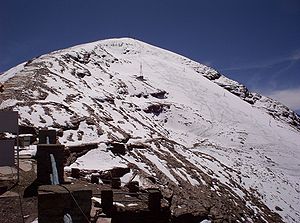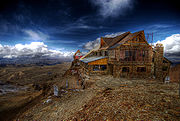
Chacaltaya
Encyclopedia
Chacaltaya is a mountain in the Cordillera Real
, one of the mountain range
s of the Cordillera Oriental, itself a range of the Bolivia
n Andes
. Its elevation is 5421 metres (17,785 ft). Chacaltaya's glacier
- which was as old as 18,000 years – had in 1940 an area of 0.22 km² (0.0849424748903577 sq mi), reduced to 0.01 km² (0.00386102158592535 sq mi) in 2007 and was completely gone by 2009. Half of the meltdown was done before 1980 (measured in volume). The final meltdown after 1980, due to missing precipitation and the warm phase of El Niňo, resulted in its final disappearance in 2009. The glacier was one of the highest glaciers in South America
, located about 30 kilometres (18.6 mi) from La Paz
, near Huayna Potosí
mountain.

 The glacier on Chacaltaya served as Bolivia's only ski resort
The glacier on Chacaltaya served as Bolivia's only ski resort
. It was the world's highest lift-served ski area, the northernmost ski area in South America
as well as the world's most equator
ial. The rope tow, the very first in South America, was built in 1939 using an automobile engine; it was notoriously fast and difficult, housed in the site's original clapboard lodge and is now inoperable. The road to the base of the 200 metres (656.2 ft) drop is reached by a narrow road, also built in the 1930s. Traditionally, due to the extreme cold weather, the lift operated exclusively on weekends from November to March. This summer glacier skiing is no longer possible following the unexpectedly early melting of the glacier. As of 2009, skiing is restricted to a 600 feet (182.9 m) stretch that sometimes receives sufficient snowfall for a run during the winter. The mountain is also popular with amateur mountaineers, as the aforementioned road stops only 200 metres (656.2 ft) from the summit.
is operated in collaboration with other universities worldwide. It is an important site for gamma ray
research. It has also been the site of medical and physiological research expeditions organized by the Apex
charity and was used for the Apex 3 expedition in July 2011.
Many Bolivians on the highland plains
, and in two of Bolivia's main cities—La Paz and El Alto—depend on the melting of Andean glaciers for their water supply during the dry season. The World Bank
has warned that many glaciers in the tropical
portion of the Andes are expected to disappear within 20 years. This will threaten the water supplies of nearly 80 million people living in the region as well as the future generation of hydropower
. Bolivia, Ecuador
and Peru
depend on hydropower for about half their electricity.
Cordillera Real (Bolivia)
The Cordillera Real is a mountain range in the South American Altiplano of Bolivia. This range of fold mountains, largely composed of granite, is located southeast of Lake Titicaca, and east of the Bolivian capital of La Paz, measuring 125 km in length and 20 km in width...
, one of the mountain range
Mountain range
A mountain range is a single, large mass consisting of a succession of mountains or narrowly spaced mountain ridges, with or without peaks, closely related in position, direction, formation, and age; a component part of a mountain system or of a mountain chain...
s of the Cordillera Oriental, itself a range of the Bolivia
Bolivia
Bolivia officially known as Plurinational State of Bolivia , is a landlocked country in central South America. It is the poorest country in South America...
n Andes
Andes
The Andes is the world's longest continental mountain range. It is a continual range of highlands along the western coast of South America. This range is about long, about to wide , and of an average height of about .Along its length, the Andes is split into several ranges, which are separated...
. Its elevation is 5421 metres (17,785 ft). Chacaltaya's glacier
Glacier
A glacier is a large persistent body of ice that forms where the accumulation of snow exceeds its ablation over many years, often centuries. At least 0.1 km² in area and 50 m thick, but often much larger, a glacier slowly deforms and flows due to stresses induced by its weight...
- which was as old as 18,000 years – had in 1940 an area of 0.22 km² (0.0849424748903577 sq mi), reduced to 0.01 km² (0.00386102158592535 sq mi) in 2007 and was completely gone by 2009. Half of the meltdown was done before 1980 (measured in volume). The final meltdown after 1980, due to missing precipitation and the warm phase of El Niňo, resulted in its final disappearance in 2009. The glacier was one of the highest glaciers in South America
South America
South America is a continent situated in the Western Hemisphere, mostly in the Southern Hemisphere, with a relatively small portion in the Northern Hemisphere. The continent is also considered a subcontinent of the Americas. It is bordered on the west by the Pacific Ocean and on the north and east...
, located about 30 kilometres (18.6 mi) from La Paz
La Paz
Nuestra Señora de La Paz is the administrative capital of Bolivia, as well as the departmental capital of the La Paz Department, and the second largest city in the country after Santa Cruz de la Sierra...
, near Huayna Potosí
Huayna Potosí
Huayna Potosí is a mountain in Bolivia, located about 25 km north of La Paz in the Cordillera Real.Huayna Potosí is the closest high mountain to La Paz, a city which is surrounded by high mountains, and itself is the highest capital city in the world. Huayna Potosí is roughly fifteen miles due...
mountain.

Ski area

Ski resort
A ski resort is a resort developed for skiing and other winter sports. In Europe a ski resort is a town or village in a ski area - a mountainous area, where there are ski trails and supporting services such as hotels and other accommodation, restaurants, equipment rental and a ski lift system...
. It was the world's highest lift-served ski area, the northernmost ski area in South America
South America
South America is a continent situated in the Western Hemisphere, mostly in the Southern Hemisphere, with a relatively small portion in the Northern Hemisphere. The continent is also considered a subcontinent of the Americas. It is bordered on the west by the Pacific Ocean and on the north and east...
as well as the world's most equator
Equator
An equator is the intersection of a sphere's surface with the plane perpendicular to the sphere's axis of rotation and containing the sphere's center of mass....
ial. The rope tow, the very first in South America, was built in 1939 using an automobile engine; it was notoriously fast and difficult, housed in the site's original clapboard lodge and is now inoperable. The road to the base of the 200 metres (656.2 ft) drop is reached by a narrow road, also built in the 1930s. Traditionally, due to the extreme cold weather, the lift operated exclusively on weekends from November to March. This summer glacier skiing is no longer possible following the unexpectedly early melting of the glacier. As of 2009, skiing is restricted to a 600 feet (182.9 m) stretch that sometimes receives sufficient snowfall for a run during the winter. The mountain is also popular with amateur mountaineers, as the aforementioned road stops only 200 metres (656.2 ft) from the summit.
Observatory
The Mount Chacaltaya Laboratory began as a weather station in 1942. Located at 5270 metres (17,290 ft), the Chacaltaya Astrophysical Observatory (Observatorio de Física Cósmica) of the Universidad Mayor de San AndrésHigher University of San Andrés
The Higher University of San Andres is a university in La Paz, Bolivia. It was founded in 1830....
is operated in collaboration with other universities worldwide. It is an important site for gamma ray
Gamma ray
Gamma radiation, also known as gamma rays or hyphenated as gamma-rays and denoted as γ, is electromagnetic radiation of high frequency . Gamma rays are usually naturally produced on Earth by decay of high energy states in atomic nuclei...
research. It has also been the site of medical and physiological research expeditions organized by the Apex
Apex (altitude physiology expeditions)
Apex is a high altitude medical research charity. It is based in Edinburgh, Scotland and was founded in 2000. It has conducted two high altitude research expeditions to the Chacaltaya high altitude laboratory, in Bolivia....
charity and was used for the Apex 3 expedition in July 2011.
Retreat of Chacaltaya glacier
Scientists at the Mount Chacaltaya Laboratory started measuring the Chacaltaya glacier in the 1990s. Predicted at that time to survive until 2015, the Chacaltaya glacier has melted at a much faster rate than expected. The 18,000 year old glacier has been reduced in recent years to just a few small patches of ice and snow near the top of the mountain.Many Bolivians on the highland plains
Altiplano
The Altiplano , in west-central South America, where the Andes are at their widest, is the most extensive area of high plateau on Earth outside of Tibet...
, and in two of Bolivia's main cities—La Paz and El Alto—depend on the melting of Andean glaciers for their water supply during the dry season. The World Bank
World Bank
The World Bank is an international financial institution that provides loans to developing countries for capital programmes.The World Bank's official goal is the reduction of poverty...
has warned that many glaciers in the tropical
Tropics
The tropics is a region of the Earth surrounding the Equator. It is limited in latitude by the Tropic of Cancer in the northern hemisphere at approximately N and the Tropic of Capricorn in the southern hemisphere at S; these latitudes correspond to the axial tilt of the Earth...
portion of the Andes are expected to disappear within 20 years. This will threaten the water supplies of nearly 80 million people living in the region as well as the future generation of hydropower
Hydropower
Hydropower, hydraulic power, hydrokinetic power or water power is power that is derived from the force or energy of falling water, which may be harnessed for useful purposes. Since ancient times, hydropower has been used for irrigation and the operation of various mechanical devices, such as...
. Bolivia, Ecuador
Ecuador
Ecuador , officially the Republic of Ecuador is a representative democratic republic in South America, bordered by Colombia on the north, Peru on the east and south, and by the Pacific Ocean to the west. It is one of only two countries in South America, along with Chile, that do not have a border...
and Peru
Peru
Peru , officially the Republic of Peru , is a country in western South America. It is bordered on the north by Ecuador and Colombia, on the east by Brazil, on the southeast by Bolivia, on the south by Chile, and on the west by the Pacific Ocean....
depend on hydropower for about half their electricity.

